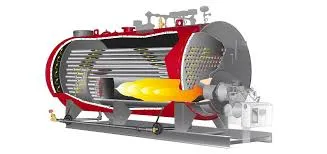
Feb . 10, 2025 11:29 Back to list
coal fired thermal oil boiler
In the evolving landscape of energy solutions, the coal-fired thermal oil boiler holds a strategic position as a robust option for industries requiring consistent and high-temperature energy output. This specificity makes them indispensable for applications ranging from chemical processing to wood manufacturing and textile production. In a market inundated with various energy solutions, understanding the key attributes of coal-fired thermal oil boilers is crucial in choosing the right system optimized for both performance and environmental considerations.
Furthermore, the expertise behind coal-fired thermal oil boilers is backed by decades of engineering refinement and operational feedback. Engineers and technical specialists from major manufacturers collaborate closely with end-users to tailor systems that meet specific industrial demands. This synergy between producer and consumer not only enhances product effectiveness but also instills a sense of trustworthiness and safety. Updated training protocols and user manuals empower operators to run the systems efficiently and to troubleshoot any operational issues with ease, further promoting a secure and efficient working environment. Authoritativeness in this domain extends to a wide network of industry stakeholders who advocate for and validate the use of coal-fired thermal oil boilers. Industrial and academic studies repeatedly verify the systems' efficiency, longevity, and adaptability to various energy projects. Continuous research underscores the relevance of these boilers, positioning them as a reliable alternative amidst the global shift towards sustainable and economical energy solutions. When deliberating on the acquisition of a coal-fired thermal oil boiler, consider the manufacturer’s history of innovation and client satisfaction. The best manufacturers provide warranties or extended service options, highlighting their confidence in product durability and performance. Peer reviews and case studies from current users can additionally provide insights into real-world performance metrics, reinforcing trust in the system's capability to deliver consistent thermal output reliably. In conclusion, coal-fired thermal oil boilers embody a harmonious balance between cost, performance, and environmental compliance, making them a viable option for industries that require sustained high temperatures. Their design and functionality reflect a commitment to advancing industrial energy solutions while adhering to environmental commitments. By leveraging advanced technologies and maintaining a focus on efficiency and user safety, they serve as a testament to the evolving story of energy management in the industrial world.


Furthermore, the expertise behind coal-fired thermal oil boilers is backed by decades of engineering refinement and operational feedback. Engineers and technical specialists from major manufacturers collaborate closely with end-users to tailor systems that meet specific industrial demands. This synergy between producer and consumer not only enhances product effectiveness but also instills a sense of trustworthiness and safety. Updated training protocols and user manuals empower operators to run the systems efficiently and to troubleshoot any operational issues with ease, further promoting a secure and efficient working environment. Authoritativeness in this domain extends to a wide network of industry stakeholders who advocate for and validate the use of coal-fired thermal oil boilers. Industrial and academic studies repeatedly verify the systems' efficiency, longevity, and adaptability to various energy projects. Continuous research underscores the relevance of these boilers, positioning them as a reliable alternative amidst the global shift towards sustainable and economical energy solutions. When deliberating on the acquisition of a coal-fired thermal oil boiler, consider the manufacturer’s history of innovation and client satisfaction. The best manufacturers provide warranties or extended service options, highlighting their confidence in product durability and performance. Peer reviews and case studies from current users can additionally provide insights into real-world performance metrics, reinforcing trust in the system's capability to deliver consistent thermal output reliably. In conclusion, coal-fired thermal oil boilers embody a harmonious balance between cost, performance, and environmental compliance, making them a viable option for industries that require sustained high temperatures. Their design and functionality reflect a commitment to advancing industrial energy solutions while adhering to environmental commitments. By leveraging advanced technologies and maintaining a focus on efficiency and user safety, they serve as a testament to the evolving story of energy management in the industrial world.
Share
Next:
Latest News
-
High-Efficiency Commercial Oil Fired Steam Boiler for Industry
NewsJul.30,2025
-
High-Efficiency Biomass Fired Thermal Oil Boiler Solutions
NewsJul.30,2025
-
High Efficiency Gas Fired Thermal Oil Boiler for Industrial Heating
NewsJul.29,2025
-
High-Efficiency Gas Fired Hot Water Boiler for Sale – Reliable & Affordable
NewsJul.29,2025
-
High Efficiency Biomass Fired Hot Water Boiler for Industrial and Commercial Use
NewsJul.29,2025
-
High-Efficiency Biomass Fired Hot Water Boiler for Industrial Use
NewsJul.28,2025
Related PRODUCTS
Copyright © 2025 HEBEI HONGZE BOILER MANUFACTURING CO., LTD. All Rights Reserved. Sitemap | Privacy Policy






















